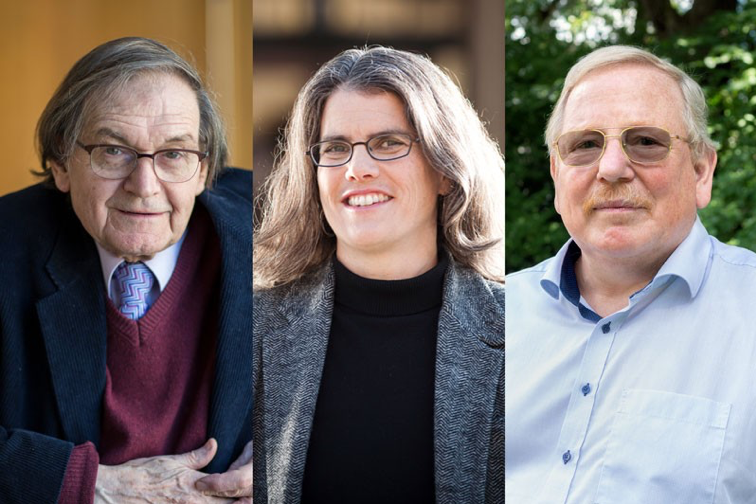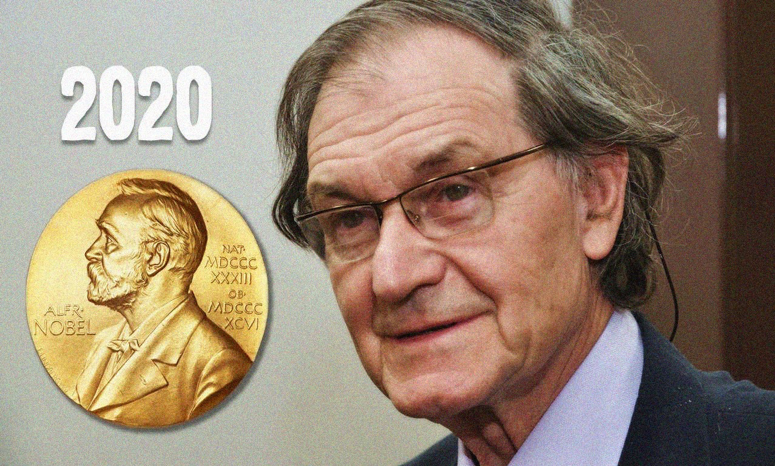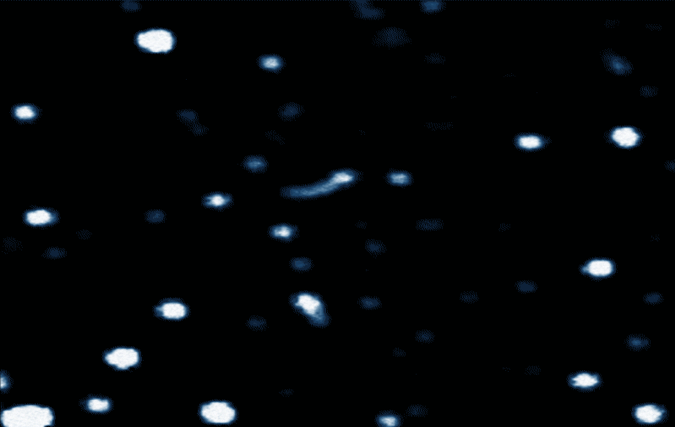
Roger Penrose (Mathematician) shares the Nobel Prize In Physics with two other astronomers, Andrea Ghez & Reinhard Genzel, on discovering a giant black hole in the Milky Way Galaxy centre
Richard Feynman, the American theoretical physicist, once said: "Mathematicians are only dealing with the structure of the reasoning and they do not really care about what they're talking. The physicist, on the other hand, has meaning to all the phrases."
The Nobel Prize 2020 in Physics for the discoveries concerning the massive and mysterious compact objects in the Universe, like black holes, was shared by a mathematical physicist and two astronomers. Roger Penrose, 89, a British mathematical physicist, earns half of the award for his theoretical frame work that showed how the general relativity theory of Albert Einstein can result in the black holes that have a strong gravitational force that even light cannot escape through it. On the other hand US astronomer Andrea Ghez, and the German astronomer Reinhard Genzel, share the other half of the US$ 1.1-million (10-million-kronor) prize for the discovery of a compact object at the centre of the Milky Way Galaxy.
Andrea Ghez and Reinhard Genzel have each led some groups since the 1990s, that have mapped orbits of the stars near the Galactic Centre of Galaxy. These are the studies that have led them to concluding that the frantic motions of the stars must be determined by an incredibly massive, unseen entity. The most credible proof yet of the supermassive black hole in the middle of the Galaxy is the object known as Sgr A * (Sagittarius A *).

Who is Giant in Physics?
An astrophysicist, Monica Colpi, in Italy at the University of Milan Bicocca, says that the awards are highly deserved. "In the ability to track the movements of stars around this object, the observational data given by Andrea Ghez and Reinhard Genzel is splendid and unique." This observational data showed that the Sgr A * has consistent density with being a supermassive black hole.
Another astrophysicist, Heino Falcke is in agreement. Heino Falcke, who is in Netherlands at Radboud University in Nijmegen, says, "They have made some fundamental contributions in establishing that these dark hearts of the galaxies exist." Another astrophysicist from UK, Carole Mundell, at the University of Bath, says that, Roger Penrose, meanwhile, is "a giant in the theoretical physics," who has inspired scientist’s generations. She adds that he is "a truly innovative thinker with tremendous creativity, with passion and sense of fun for the curiosity in everything he does."
Andrea Ghez is just the fourth woman in the world to receive the Nobel Prize in Physics at the University of California, Los Angeles. Back in 2018, when she became only the third woman to receive a physics award, Donna Strickland a laser physicist ended a 55 year drought. "I take responsibility that associated with becoming the fourth woman in the world to receive the Nobel [physics] Prize very seriously", in a press conference Andrea Ghez said that, I hope I will be able to encourage some other young and emerging women to join the profession. It is a kind of field that has too many delights.
General relativity to geometry
In a seminal paper (1965), Roger Penrose showed how black holes could form, according to general relativity, provided the right conditions, the creation of the surface that traps the light. Mass enters an inevitable gravitational collapse within this rock, creating a area called a singularity, of infinitely dense energy. This inevitability was seen by previous researchers only under conditions which were considered physically impossible.
The contributions from Penrose cover many fields of physics and mathematics. He had interactions with one of the incredible graphic artist M.C. Escher and inspired some of his sketches of geometrical shapes that seemed unlikely. He developed a geometric theory in the 1970s: from all of these sketches a non-repeating 2 dimensional pattern now known as Penrose tilings. In the quasicrystals, which were the topic of the Nobel Prize (2011) in the field of Chemistry, such patterns occur in nature. A mathematical physicist, Matilde Marcolli, at the California Institute of Technology in Pasadena, currently working with Roger Penrose, says that Penrose incorporated complex mathematical methods into many branches of physics. She says, "It was a whole different way of thinking." Penrose specifically developed the theory of 'twistor spaces' in the late 1960s, which is the attempt to reconcile quantum mechanics (QM) with general relativity (GR), says by a Pakistani mathematical physicist Dr. Asghar Qadir who is currently working at the National Center for Mathematics (Also known as Abdus Salam school of Mathematical Sciences) of Pakistan in Lahore. Spaces in Twistor will alter the very essence of space time. He developed the concept that the space and time can be spoken about not as the fundamental thing itself, but another evolving thing, "says Asghar Qadir, who did his PhD degree on twistor theory with Roger Penrose."
The mathematical physicist, along with the late Stephen Hawking, also did more foundational work on singularities. "I would assume that it is also implicitly given to Stephen Hawking to give the award to Penrose and it honours the enormous efforts of these two individuals and their team mates have put into the theoretical physical interpretation of black hole phenomenon," says by a German astrophysicist, Andreas Eckart, at the University of Cologne.
What is dark heart in Physics?
Although Roger Penrose laid the theoretical foundations for the black holes to exist, the teams of Ghez and Genzel provided an experimental and powerful proof that such a void is at the heart of our Milky Way Galaxy. Astronomers have speculated since 1960s that a black hole would lie at the centre of most galaxies, with more than a million times mass that of our Sun. A prime candidate was The Milky Way, the energetic emissions from the core of The Milky Way Galaxy, the object known as the Sgr A *, were disclosed by radio observations. A centre lined with the stars and gas hurtling at the high speeds was seen by other observations.
But it was a challenge to peer closely at these stars, since gas and dust blurred the emissions of the stars. To resolve this challenge, competing teams led by Andrea Ghez and Reinhard Genzel used some of largest telescopes in the world, the Mauna Kea, Hawaii observatory known as Keck, and at the Cerro Paranal, Chile a very large Telescope, respectively, starting in the 1990s, and cutting-edge observational techniques.
Finding ways to improve their resolution and exposure to faint light was key to their work, says Eckart, a former Genzel team member at Germany in the Max Planck Institute for Extraterrestrial Physics, Garching. Next, the groups took data in snapshots using a method known as speckle imaging to prevent the blurring induced by the turbulence in the atmosphere of the Earth. Later, both teams used adaptive optics to correct the distortion, using a mirror. This results longer exposures to catch more light and increase sensitivity, enabling them to track the movement of stars in 3 dimensions as well. These techniques have allowed these teams to calculate thousands of the stars near the Galactic Centre over decades and plot the orbits of around thirty. Ultimately, the two teams calculated the object's mass, around the four million solar masses, and decided an upper limit on its size.
The finding at the Milky Way 's centre there is a supermassive black hole was the result of their team efforts, many articles and many ventures, Eckart says. Eckart, who still collaborates with the laureate, says that Reinhard Genzel always known for being a hard worker. He's very succinct, "he says," and a very good scientist. According to Nature profile (2013) of the astronomer, meanwhile Andrea Ghez is known for having a cheerful strength and fierce dedication to her work. She's very centred person who takes a very straightforward approach to the issues, "Eckart continues.
Richard Feynman, the American theoretical physicist, once said: "Mathematicians are only dealing with the structure of the reasoning and they do not really care about what they're talking. The physicist, on the other hand, has meaning to all the phrases."
The Nobel Prize 2020 in Physics for the discoveries concerning the massive and mysterious compact objects in the Universe, like black holes, was shared by a mathematical physicist and two astronomers. Roger Penrose, 89, a British mathematical physicist, earns half of the award for his theoretical frame work that showed how the general relativity theory of Albert Einstein can result in the black holes that have a strong gravitational force that even light cannot escape through it. On the other hand US astronomer Andrea Ghez, and the German astronomer Reinhard Genzel, share the other half of the US$ 1.1-million (10-million-kronor) prize for the discovery of a compact object at the centre of the Milky Way Galaxy.
Andrea Ghez and Reinhard Genzel have each led some groups since the 1990s, that have mapped orbits of the stars near the Galactic Centre of Galaxy. These are the studies that have led them to concluding that the frantic motions of the stars must be determined by an incredibly massive, unseen entity. The most credible proof yet of the supermassive black hole in the middle of the Galaxy is the object known as Sgr A * (Sagittarius A *).

Who is Giant in Physics?
An astrophysicist, Monica Colpi, in Italy at the University of Milan Bicocca, says that the awards are highly deserved. "In the ability to track the movements of stars around this object, the observational data given by Andrea Ghez and Reinhard Genzel is splendid and unique." This observational data showed that the Sgr A * has consistent density with being a supermassive black hole.
Another astrophysicist, Heino Falcke is in agreement. Heino Falcke, who is in Netherlands at Radboud University in Nijmegen, says, "They have made some fundamental contributions in establishing that these dark hearts of the galaxies exist." Another astrophysicist from UK, Carole Mundell, at the University of Bath, says that, Roger Penrose, meanwhile, is "a giant in the theoretical physics," who has inspired scientist’s generations. She adds that he is "a truly innovative thinker with tremendous creativity, with passion and sense of fun for the curiosity in everything he does."
Andrea Ghez is just the fourth woman in the world to receive the Nobel Prize in Physics at the University of California, Los Angeles. Back in 2018, when she became only the third woman to receive a physics award, Donna Strickland a laser physicist ended a 55 year drought. "I take responsibility that associated with becoming the fourth woman in the world to receive the Nobel [physics] Prize very seriously", in a press conference Andrea Ghez said that, I hope I will be able to encourage some other young and emerging women to join the profession. It is a kind of field that has too many delights.
General relativity to geometry
In a seminal paper (1965), Roger Penrose showed how black holes could form, according to general relativity, provided the right conditions, the creation of the surface that traps the light. Mass enters an inevitable gravitational collapse within this rock, creating a area called a singularity, of infinitely dense energy. This inevitability was seen by previous researchers only under conditions which were considered physically impossible.
The contributions from Penrose cover many fields of physics and mathematics. He had interactions with one of the incredible graphic artist M.C. Escher and inspired some of his sketches of geometrical shapes that seemed unlikely. He developed a geometric theory in the 1970s: from all of these sketches a non-repeating 2 dimensional pattern now known as Penrose tilings. In the quasicrystals, which were the topic of the Nobel Prize (2011) in the field of Chemistry, such patterns occur in nature. A mathematical physicist, Matilde Marcolli, at the California Institute of Technology in Pasadena, currently working with Roger Penrose, says that Penrose incorporated complex mathematical methods into many branches of physics. She says, "It was a whole different way of thinking." Penrose specifically developed the theory of 'twistor spaces' in the late 1960s, which is the attempt to reconcile quantum mechanics (QM) with general relativity (GR), says by a Pakistani mathematical physicist Dr. Asghar Qadir who is currently working at the National Center for Mathematics (Also known as Abdus Salam school of Mathematical Sciences) of Pakistan in Lahore. Spaces in Twistor will alter the very essence of space time. He developed the concept that the space and time can be spoken about not as the fundamental thing itself, but another evolving thing, "says Asghar Qadir, who did his PhD degree on twistor theory with Roger Penrose."
The mathematical physicist, along with the late Stephen Hawking, also did more foundational work on singularities. "I would assume that it is also implicitly given to Stephen Hawking to give the award to Penrose and it honours the enormous efforts of these two individuals and their team mates have put into the theoretical physical interpretation of black hole phenomenon," says by a German astrophysicist, Andreas Eckart, at the University of Cologne.
What is dark heart in Physics?
Although Roger Penrose laid the theoretical foundations for the black holes to exist, the teams of Ghez and Genzel provided an experimental and powerful proof that such a void is at the heart of our Milky Way Galaxy. Astronomers have speculated since 1960s that a black hole would lie at the centre of most galaxies, with more than a million times mass that of our Sun. A prime candidate was The Milky Way, the energetic emissions from the core of The Milky Way Galaxy, the object known as the Sgr A *, were disclosed by radio observations. A centre lined with the stars and gas hurtling at the high speeds was seen by other observations.
 (Time lapse of the observations from the party from the Reinhard Genzel Shows stars orbiting at the central black hole of the Milky Way for over 20 years.)
(Time lapse of the observations from the party from the Reinhard Genzel Shows stars orbiting at the central black hole of the Milky Way for over 20 years.)
But it was a challenge to peer closely at these stars, since gas and dust blurred the emissions of the stars. To resolve this challenge, competing teams led by Andrea Ghez and Reinhard Genzel used some of largest telescopes in the world, the Mauna Kea, Hawaii observatory known as Keck, and at the Cerro Paranal, Chile a very large Telescope, respectively, starting in the 1990s, and cutting-edge observational techniques.
Finding ways to improve their resolution and exposure to faint light was key to their work, says Eckart, a former Genzel team member at Germany in the Max Planck Institute for Extraterrestrial Physics, Garching. Next, the groups took data in snapshots using a method known as speckle imaging to prevent the blurring induced by the turbulence in the atmosphere of the Earth. Later, both teams used adaptive optics to correct the distortion, using a mirror. This results longer exposures to catch more light and increase sensitivity, enabling them to track the movement of stars in 3 dimensions as well. These techniques have allowed these teams to calculate thousands of the stars near the Galactic Centre over decades and plot the orbits of around thirty. Ultimately, the two teams calculated the object's mass, around the four million solar masses, and decided an upper limit on its size.
The finding at the Milky Way 's centre there is a supermassive black hole was the result of their team efforts, many articles and many ventures, Eckart says. Eckart, who still collaborates with the laureate, says that Reinhard Genzel always known for being a hard worker. He's very succinct, "he says," and a very good scientist. According to Nature profile (2013) of the astronomer, meanwhile Andrea Ghez is known for having a cheerful strength and fierce dedication to her work. She's very centred person who takes a very straightforward approach to the issues, "Eckart continues.
